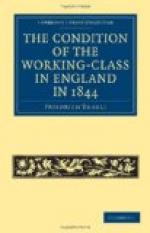on Medlock; still farther, pretty well to the east
of Manchester, Ardwick. The whole assemblage
of buildings is commonly called Manchester, and contains
about four hundred thousand inhabitants, rather more
than less. The town itself is peculiarly built,
so that a person may live in it for years, and go
in and out daily without coming into contact with a
working-people’s quarter or even with workers,
that is, so long as he confines himself to his business
or to pleasure walks. This arises chiefly from
the fact, that by unconscious tacit agreement, as well
as with outspoken conscious determination, the working-people’s
quarters are sharply separated from the sections of
the city reserved for the middle-class; or, if this
does not succeed, they are concealed with the cloak
of charity. Manchester contains, at its heart,
a rather extended commercial district, perhaps half
a mile long and about as broad, and consisting almost
wholly of offices and warehouses. Nearly the
whole district is abandoned by dwellers, and is lonely
and deserted at night; only watchmen and policemen
traverse its narrow lanes with their dark lanterns.
This district is cut through by certain main thoroughfares
upon which the vast traffic concentrates, and in which
the ground level is lined with brilliant shops.
In these streets the upper floors are occupied, here
and there, and there is a good deal of life upon them
until late at night. With the exception of this
commercial district, all Manchester proper, all Salford
and Hulme, a great part of Pendleton and Chorlton,
two-thirds of Ardwick, and single stretches of Cheetham
Hill and Broughton are all unmixed working-people’s
quarters, stretching like a girdle, averaging a mile
and a half in breadth, around the commercial district.
Outside, beyond this girdle, lives the upper and middle
bourgeoisie, the middle bourgeoisie in regularly laid
out streets in the vicinity of the working quarters,
especially in Chorlton and the lower lying portions
of Cheetham Hill; the upper bourgeoisie in remoter
villas with gardens in Chorlton and Ardwick, or on
the breezy heights of Cheetham Hill, Broughton, and
Pendleton, in free, wholesome country air, in fine,
comfortable homes, passed once every half or quarter
hour by omnibuses going into the city. And the
finest part of the arrangement is this, that the members
of this money aristocracy can take the shortest road
through the middle of all the labouring districts to
their places of business, without ever seeing that
they are in the midst of the grimy misery that lurks
to the right and the left. For the thoroughfares
leading from the Exchange in all directions out of
the city are lined, on both sides, with an almost
unbroken series of shops, and are so kept in the hands
of the middle and lower bourgeoisie, which, out of
self-interest, cares for a decent and cleanly external
appearance and can care for it. True,
these shops bear some relation to the districts which
lie behind them, and are more elegant in the commercial




